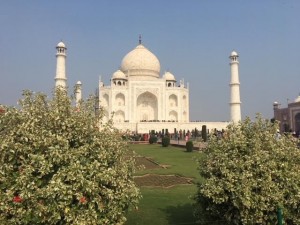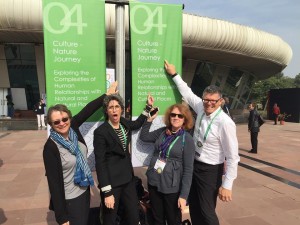
UNESCO World Heritage Site Agra India
The recent Scientific Symposium at the 19th ICOMOS Triennial General Assembly in India (December 11-15, 2017) featured a track titled a “Culture/Nature Journey” that highlighted how the recognition of the interconnected character of natural and cultural heritage is critical for the future of conservation. The idea for this track was inspired by the September 2016 ‘Nature-Culture Journey’ launched a little over a year ago (September 2016) at the IUCN World Conservation Congress in Hawai’i. At the Congress, a week-long ‘Journey’ offered sessions and discussions that reflected on the importance of integrating the work of conservation. The two fields have been brought together by the growing evidence that lasting conservation of natural and cultural heritage in landscapes/seascapes depends on better integration for resource planning and management. The need for this approach is made more urgent by threats such as climate change, urban expansion and globalization that can only be addressed on a large landscape scale.
At the ICOMOS meeting in New Delhi, the Journey continued under Co Chairs Susan Mcintyre-Tamwoy of ICOMOS and Tim Badman of IUCN. A special track titled appropriately Culture/Nature consisted of 13 workshops, many providing updates on existing programs of the two organizations on this topic, 7 small focused Knowledge Cafes, 4 more traditional Paper Session, 2 Case Study Sessions and other events including a Culture/Nature lunch.
So what were some of the highlights?

New Delhi
An important initiative is the joint ICOMOS/IUCN Connecting Practice Project. The goal of this effort is to explore how to link culture and nature through selected pilot projects at World Heritage sites. Leaders in this effort updated attendees on the fieldwork that has been carried out over the past few years and discussed its application to varied landscapes/seascapes. A key element has been the partnership with local and national management authorities who have been working to develop and strengthen policy and management frameworks to achieve long- term conservation and maintain biocultural resilience in regions as disparate as Mongolia, Hungary and South Africa.
Another capacity building initiative presented at the ‘Journey’ was an update on World Heritage Leadership an effort to improve the conservation and management practices for culture and nature as a component of sustainable development. One proposed idea to better meld the practice of culture and nature is to publish a new integrated resource manual, which joins together the existing ICCROM-led Managing Cultural World Heritage manual with the IUCN-led Managing Natural World Heritage manual to be issued by 2020. As session leaders noted the current existence of the two separate manuals itself illustrates the existing divide.
A workshop also focused on how the Rights-Based Approaches (RBAs) can be more effectively framed and mainstreamed using a nature/culture approach to improve the effectiveness conservation and sustainable management in partnership with indigenous communities. Considering both values can enhance the experience of local communities with biodiversity conservation and reconnect people with their natural heritage.
Several workshops looked at the challenging issue of agriculture. These landscapes stand at the nexus of nature and culture and are repositories of bio- cultural diversity, associated intangible and tangible cultural heritage, including the physical shaping of the landscape and associated traditional knowledge and practice. However, there can be tension around the management of working landscapes. The challenge is to form new alliances among the traditional stewards of these landscapes and heritage conservation organizations that inter-weave of nature and culture, and that consider how these values can help to advance sustainability in the long term. One effort aimed at building crosscutting understanding is the World Rural Landscape initiative, which explores the entangled cultural and natural dimensions of rural and agrarian landscapes and examines conservation approaches for sustainability of these dynamic systems.
This is just a taste of the topics that were covered in the Culture/Nature Journey in New Delhi. For further information, all of the session abstracts are available here.

As for outcomes on this Journey: An important step forward was the adoption of two resolutions at the conclusion of the 19th ICOMOS Triennial General Assembly that document forward motion on culture/nature journey.
- Adopted Resolution 19 2017/25 “Incorporating the interconnectedness of Nature and Culture into Heritage Conservation”
- Adopted Resolution 19GA 2017/16 Adoption of the ICOMOS/IFLA “Principles concerning Rural landscapes as Heritage”
Also during the conference, a hardworking group attempted to distill the essence of many sessions and conversations. One message from this exercise was that success might be achieved by parties taking small steps aligned toward a common goal. There will be many more reports coming out of this event, but for some additional background visit the Culture Nature Journey Facebook page.
Postscript:
Just a reminder that the highlights of the Journey at the Word Conservation Congress (September 2017) were captured in a recent issue of the George Wright Forum titled Nature Culture Journeys: Exploring Shared Terrain. This thematic issue of the George Wright Forum draws examples from this broad array of themes through examples of case studies and reflections on the journey experience. While not comprehensive overview of the Nature-Culture Journey, together these papers illustrate many of the important emergent themes from that gathering.
Explore this issue on the George Wright web site.


